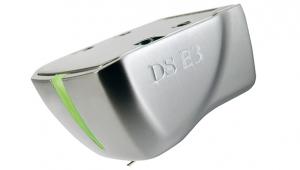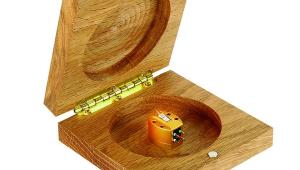DS Audio DS-E1 Cartridge

 Following a flow of revolutionary, hugely desirable but astronomically-priced 'optical' cartridges, DS Audio introduces the DS-E1 – could 'E' stand for 'Everyman'?
Following a flow of revolutionary, hugely desirable but astronomically-priced 'optical' cartridges, DS Audio introduces the DS-E1 – could 'E' stand for 'Everyman'?
This is the second review this month that's been tough for me to write if, in this instance, for entirely positive reasons. You see, the DS Audio DS-E1 is actually too good, and the asking price of £2295 is the reason. I do not want to inflict any hardship upon DS Audio, which offers three models above this, but, like an entry-level Rolex, Leica CL camera or Porsche Cayman, it begs the question: why pay more?
While still a fair chunk of change to most people, by today's measure £2295 is not an extreme amount to pay for a true high-end cartridge of sublime performance together with, in this case, what is effectively a phono stage. Yes, you read that correctly: this includes all that's needed to feed your vinyl into a line-level-only preamp, integrated or receiver.
Body Shop
That's because the DS Audio DS-E1, like its far dearer siblings, requires a dedicated energiser that also provides RIAA equalisation. All models have corresponding energiser boxes, but these are interchangeable. Where DS Audio's models differ is in cantilever and stylus type, as well as body and illumination colours for easy identification. The DS-E1's prow-mounted lamp glows green and its body is a semi-matt silver.
This commonality is a boon when swapping from one model to the next (for retailers or reviewers!) because the 8.1g weight, overhang, VTA and tracking force of 1.7g are identical for every model. Thus, what you are paying for are differing body materials, better cantilevers/styli and superior energisers. Working from the top of the range downward, they comprise: DS Master 1 [HFN Dec '17] with 'ultra-duralumin' body, sapphire cantilever and Micro Ridge stylus; the DS-W2 [HFN Jan '19] with aluminium body, boron cantilever, Micro Ridge stylus; and DS-002 [HFN Jun '17] with aluminium body and cantilever, plus Shibata stylus. The DS-E1 shares the body and cantilever materials with the DS-002, but the stylus has an elliptical profile.
As for the energisers, they vary in their power supplies, features and other details, and they do sound different. This also provides enthusiasts with a major test and upgrade opportunity – imagine a deck with four identical tonearms, like a TechDAS Air Force III [HFN Sep '16], or V [HFN Jan '19], feeding the various DS models into their respective energisers, then swapping them around, ultimately trying them all into the DS Master 1 energiser. You would soon hear how different cantilevers, styli and even body materials affect the overall performance. As do the energisers.

So let's get the latter out of the way: after listening to the energiser that comes with the DS-E1 and playing with its two bass settings – I preferred Output 2 with its flatter low frequency response – I did all of the critical listening through the DS Master 1 equaliser with balanced output. I simply heard 'more' through it, but that is not to say that the DS-E1's energiser is unsatisfactory. Indeed, at the price, there's nothing unsatisfactory about this cartridge.
Well, there is one consideration, common to the entire DS range. The cartridges have uncommonly shallow bodies and certain arms – those that taper at the front and are wide at the back, or have massive cross-section/diameter tubes – might cause clearance issues with the edges of warped or extra-thick LPs.
As I do not like the idea of inserting spacers between cartridge and headshell to enable easier arm levelling and VTA setting, I would ask DS to produce the next generation of cartridges with 1mm or 2mm-taller bodies. The slight weight increase would not cause a problem.
Once installed, the DS-E1 behaves like any other cartridge, with the same requirements for gentle handling, occasional stylus cleaning, careful cueing and so on. What you will not be prepared for, upon hearing this or any DS cartridge for the first time, is the utter absence of background shmutz.
![]() Silence Is Golden
Silence Is Golden
As I soon realised, upon learning about and hearing a DS cartridge for the first time, the technology completely eliminates the low-level hum present in all cartridges using some combination of magnets and coils. No matter how low the hum, it's still there. These 'optical' pick-ups bring vinyl closer to one of digital's inarguable benefits: much reduced background noise.
As payoffs go, this one is huge, the DS-E1 being just as discreetly quiet as its dearer siblings. Immediately apparent when used through high-resolution systems, are gains in transparency and the audibility of low-level information. On 'Live And Let Die', from the new edition of Wings Greatest [MPL/Capitol 02567 37240], the DS-E1 nearly matched the Master 1 for conveying the bombastic slam of the explosions, while never obscuring the barely audible information underneath the detonation.


















































